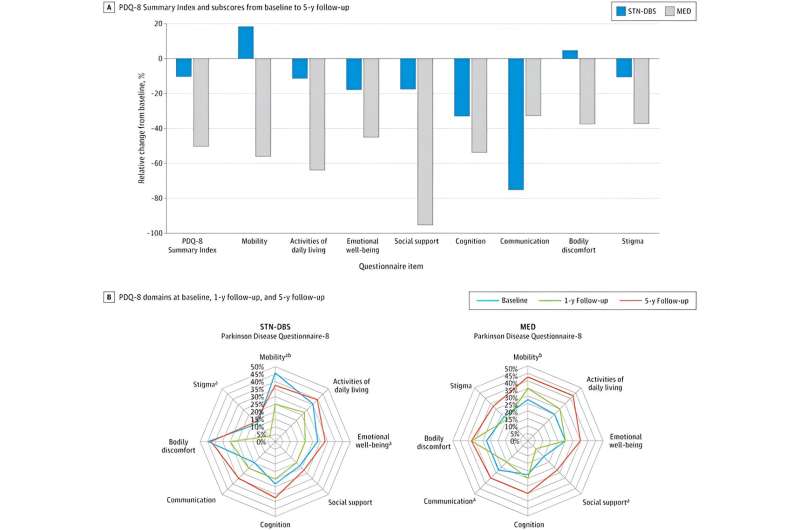Domains of quality of life and motor aspects in the patients receiving deep brain stimulation of the subthalamic nucleus (stn-dbs) vs standard-of-care medical treatment (med) for the Parkinson’s Disease Questionnaire 8 (PDQ-8), positive scores indicate improvement and negative scores indicate worsening. The PDQ-8 domain scores are illustrated as the percentage of maximum scores. More extensive areas represent more severe impairment. Credit: JAMA Network Open (2024). DOI: 10.1001/jamanetworkopen.2023.52177
For patients with Parkinson disease (PD), differences in quality of life (QOL) outcomes are seen with deep brain stimulation of the subthalamic nucleus (STN-DBS), according to a study published online Jan. 18 in JAMA Network Open.
Stefanie T. Jost, Ph.D., from the University of Cologne in Germany, and colleagues examined the long-term effects of STN-DBS versus standard-of-care medication (MED) on QOL in a prospective observational, quasi-experimental trial involving patients with PD. Overall, 108 patients underwent propensity score-matching (62 in the STN-DBS group and 46 in the MED group), resulting in a well-balanced matched subcohort with 25 patients in each group.
The researchers found that Parkinson's Disease Questionnaire 8 (PDQ-8) and activities of daily living (ADL) worsened only in the MED group at five-year follow-up (PDQ-8 change, −10.9; ADL change, −2.0), while in the STN-DBS group, both outcomes remained stable. There was a moderate correlation observed for changes in PDQ-8 and ADL. STN-DBS outcomes were favorable for motor complications, mobility, and levodopa-equivalent daily dose reduction (mean differences in change scores between STN-DBS and MED, −2.0, −1.0, and −821.4, respectively).
"These findings may provide helpful information when counseling patients on the efficacy of STN-DBS for PD and monitoring patients postoperatively in long-term follow-up," the authors write.
More information: Stefanie T. Jost et al, Neurostimulation for Advanced Parkinson Disease and Quality of Life at 5 Years, JAMA Network Open (2024). DOI: 10.1001/jamanetworkopen.2023.52177
2024 HealthDay. All rights reserved.
























